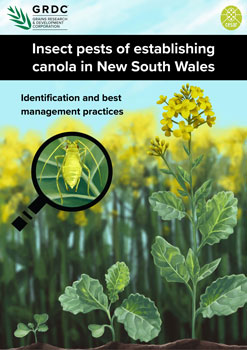Insect pests of establishing canola in NSW
Insect pests of establishing canola in NSW
Published: 15 Mar 2019
Canola can usually recover and compensate in yield from some insect damage, however there are a few insects which can get the better of it – particularly at establishment when cotyledons and young plants are most vulnerable.
This guide has been created to encourage growers and advisors to have insects front of mind before and during establishment of autumn-sown canola. This guide does not exclusively consider pests – it focuses on the good insects too. Broadacre crop paddocks are home to a wide range of beneficial insects which help suppress pest outbreaks.
This guide promotes the use of integrated pest management strategies so that insecticides are not routinely used as the first line of defence. While insecticides are and will remain useful tools, insecticide resistance prevalence, the lack of selective options, and deregulation of some insecticides, means that non-chemical control strategies must become conventional practice.
This can be challenging. Very little is known about some pest and beneficial insects and this can cause a level of uncertainty and apprehension.
Yet, some of the most notorious canola establishment pests are well researched and understood.
While this guide focuses on canola grown in NSW, differences between farms (e.g. stubble retention, soil type, native vegetation) and the conditions that determine pest distribution (e.g. rainfall, temperature, humidity) mean there is no one-size-fits-all pest management plan for the state (or even one grower’s paddocks!).
This guide brings together the big and sometimes seemingly small insect insights to assist growers and advisors in piecing together a best-bet strategy for canola establishment pests.
Download PDF
Region: National

